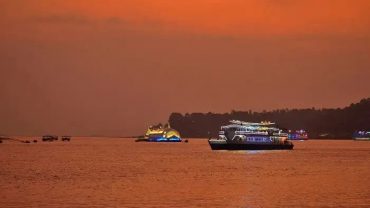In the light of recent events and changes in the valley of Kashmir, if you are planning a trip to Leh-Ladakh, then worry not because you are good to go. The scrapping of Article 370 of the Indian Constitution in the state of Jammu and Kashmir has increased the uncertainty of the state’s future, including tourism. The speculations of consequences have loomed over the valley as the government cancelled off Amarnath Yatra and asked all the tourists to leave the state. But how does all of this affect the tourism of the state, the backbone of the economy? The situation in Jammu and Kashmir is tense but Ladakh is as smooth as it was yesterday. The desert district of Ladakh is untouched by the consequences of the abrogation of the Article.

does not exist.
What Was Article 370 And What Is The Significance Of The New Bill?

Article 370 of the Constitution grants a special status to Jammu and Kashmir, while Article 35A ensures special rights to the permanent residents of Kashmir. According to the new bill, Jammu and Kashmir will be reorganised as a Union Territory with an Assembly, and Ladakh would be a separate Union Territory with no legislature. The Union government will have the Law and order powers of policing in the new UTs.
How Is The Daily Life Affected In Ladakh?

With schools and offices running smoothly like butter, the daily functioning of Ladakh has not been affected at all. Markets are open and cafes are serving. According to our local vendors, too, the business is as usual in Ladakh. There are zero cancellations from travellers yet. The officials have not imposed any restrictions on travel in and around the area. Life continues as always here. With the prospects of becoming a separate Union Territory, the tourism of Ladakh will run completely separate from the tourism of J&K. So, if you are hesitating to embark on your adventures to Ladakh, then fear not. The mountains are still calling you.
How To Reach Ladakh?

There are two routes that you can take to reach the cold mountainous desert. The first route is via Srinagar-Leh Manali. It is currently not advisable that you take this route for your own safety. The second route is via Manali and Rohtang pass, which takes you across the 475km stretch. This route is not in proximity to the valley and hence it is completely safe and good to drive on. The route is also not beefed with military troops indicating that the roads are unaffected! The government buses are also operational every alternate day from Manali to Leh and Leh to Manali. It is also a positive news that the Leh airport is running its usual business.
What Are The Conditions Of Local Transportation In Ladakh?

According to the locals, everything is functioning normal in the district of Ladakh. Only the way to Srinagar-Leh highway has been affected. According to CNT‘s report Angrub Dorje, who runs Discover Ladakh has stated, “Both Leh and Ladakh are completely safe. It is a normal day here, schools are open, the internet is working. Access to all tourist spots is open.” Most of the travel agencies will also take you via the Manali-Leh highway. WanderOn’s Leh-Ladakh tour package also takes you to Ladakh via Manali, Rohtang pass and Spiti valley. Reaching Ladakh via Manali is also cheaper than reaching your destination through Srinagar.
Where To Stay In Ladakh?

Options ranging from homestays to hotels are available for accommodation. Hotels like K2 Continental, Grand Chubi and Hotel Lumbini are available at affordable prices! There are various campsites near the vicinity of Pangong Tso like Himalayan cottage. Hotels are also open in Nubra Valley including Hotel Lhasthang. There are many camps in Jispa as well one of them being Eco camps where you can plan your stay.
Even though the situation in the paradise of India is uncertain and scary, the region of Ladakh is actually safe, with no signs of tensions and violence. So, plan without thinking twice.
Note: We will keep updating the article if further notices come out.





Customer
Can you be more specific about the content of your article? After reading it, I still have some doubts. Hope you can help me.
Customer
Thanks for sharing. I read many of your blog posts, cool, your blog is very good.
Customer
Thank you for your sharing. I am worried that I lack creative ideas. It is your article that makes me full of hope. Thank you. But, I have a question, can you help me? https://www.binance.info/it/join?ref=UM6SMJM3
Customer
Your article helped me a lot, is there any more related content? Thanks! https://accounts.binance.com/fr/register-person?ref=S5H7X3LP
Customer
Thank you for your sharing. I am worried that I lack creative ideas. It is your article that makes me full of hope. Thank you. But, I have a question, can you help me? https://www.binance.info/es/join?ref=WTOZ531Y
Customer
Your article helped me a lot, is there any more related content? Thanks! https://www.binance.com/lv/register?ref=S5H7X3LP
Customer
Thank you very much for sharing, I learned a lot from your article. Very cool. Thanks. nimabi
Customer
Your article gave me a lot of inspiration, I hope you can explain your point of view in more detail, because I have some doubts, thank you. 20bet
Customer
Apoiar ferramentas de apostas e estar equipado com uma plataforma diversificada de transações financeiras, a 20Bet oferece suporte tangível aos jogadores. Este é um lugar onde eles podem apostar com dinheiro real, respaldados por concorrentes de diversas disciplinas esportivas. 20bet
Customer
Your point of view caught my eye and was very interesting. Thanks. I have a question for you. https://accounts.binance.com/de-CH/register-person?ref=V3MG69RO